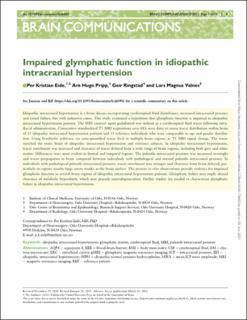| dc.contributor.author | Eide, Per Kristian | |
| dc.contributor.author | Pripp, Are Hugo | |
| dc.contributor.author | Ringstad, Geir | |
| dc.contributor.author | Valnes, Lars Magnus | |
| dc.date.accessioned | 2022-03-01T07:54:55Z | |
| dc.date.available | 2022-03-01T07:54:55Z | |
| dc.date.created | 2022-01-22T12:48:52Z | |
| dc.date.issued | 2021-03-21 | |
| dc.identifier.citation | Brain Communications. 2021, 3 (2), 1-14. | en_US |
| dc.identifier.issn | 2632-1297 | |
| dc.identifier.uri | https://hdl.handle.net/11250/2981911 | |
| dc.description.abstract | Idiopathic intracranial hypertension is a brain disease incorporating cerebrospinal fluid disturbance, increased intracranial pressure and visual failure, but with unknown cause. This study examined a hypothesis that glymphatic function is impaired in idiopathic intracranial hypertension patients. The MRI contrast agent gadobutrol was utilized as a cerebrospinal fluid tracer following intrathecal administration. Consecutive standardized T1 MRI acquisitions over 48 h were done to assess tracer distribution within brain of 15 idiopathic intracranial hypertension patients and 15 reference individuals who were comparable in age and gender distribution. Using FreeSurfer software, we semi-quantified tracer level in multiple brain regions as T1 MRI signal change. The tracer enriched the entire brain of idiopathic intracranial hypertension and reference subjects. In idiopathic intracranial hypertension, tracer enrichment was increased and clearance of tracer delayed from a wide range of brain regions, including both grey and white matter. Differences were most evident in frontal and temporal regions. The pulsatile intracranial pressure was measured overnight and tracer propagation in brain compared between individuals with pathological and normal pulsatile intracranial pressure. In individuals with pathological pulsatile intracranial pressure, tracer enrichment was stronger and clearance from brain delayed, particularly in regions nearby large artery trunks at the brain surface. The present in vivo observations provide evidence for impaired glymphatic function in several brain regions of idiopathic intracranial hypertension patients. Glymphatic failure may imply altered clearance of metabolic byproducts, which may precede neurodegeneration. Further studies are needed to characterize glymphatic failure in idiopathic intracranial hypertension. | en_US |
| dc.description.sponsorship | This work was supported by grants from Health South-East, Norway (grants 2020068), and from Department of Neurosurgery, Oslo University Hospital-Rikshospitalet, Oslo, Norway. | en_US |
| dc.language.iso | eng | en_US |
| dc.publisher | Oxford University Press | en_US |
| dc.relation.ispartofseries | Brain Communications;Volume 3, Issue 2 | |
| dc.rights | Navngivelse 4.0 Internasjonal | * |
| dc.rights.uri | http://creativecommons.org/licenses/by/4.0/deed.no | * |
| dc.subject | Idiopathic intracranial hypertension | en_US |
| dc.subject | Glymphatic systems | en_US |
| dc.subject | Cerebrospinal fluids | en_US |
| dc.subject | MRI | en_US |
| dc.subject | Pulsatile intracranial pressure | en_US |
| dc.title | Impaired glymphatic function in idiopathic intracranial hypertension | en_US |
| dc.type | Peer reviewed | en_US |
| dc.type | Journal article | en_US |
| dc.description.version | publishedVersion | en_US |
| dc.rights.holder | © The Author(s) (2021) | en_US |
| dc.source.articlenumber | fcab043 | en_US |
| cristin.ispublished | true | |
| cristin.fulltext | original | |
| cristin.qualitycode | 1 | |
| dc.identifier.doi | https://doi.org/10.1093/braincomms/fcab043 | |
| dc.identifier.cristin | 1987746 | |
| dc.source.journal | Brain Communications | en_US |
| dc.source.volume | 3 | en_US |
| dc.source.issue | 2 | en_US |
| dc.source.pagenumber | 1-14 | en_US |

